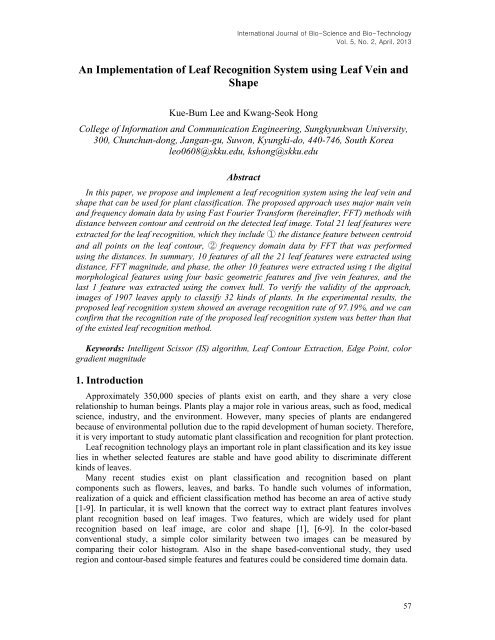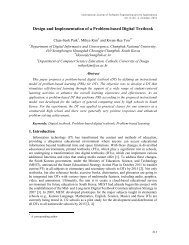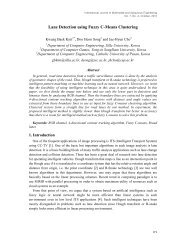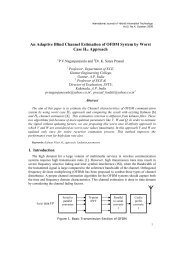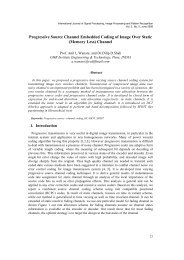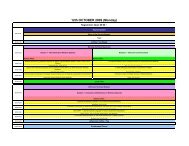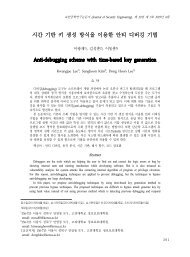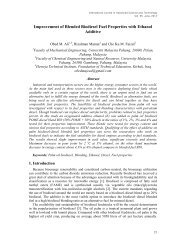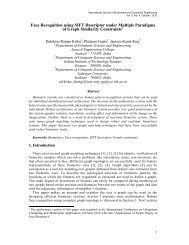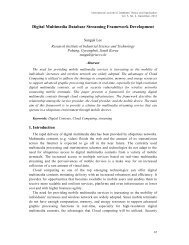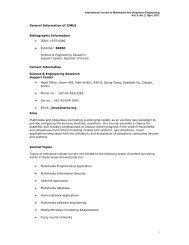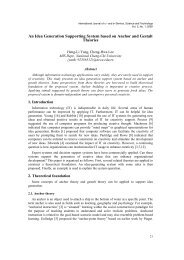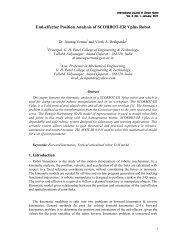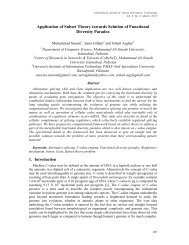An Implementation of Leaf Recognition System using Leaf Vein and ...
An Implementation of Leaf Recognition System using Leaf Vein and ...
An Implementation of Leaf Recognition System using Leaf Vein and ...
Create successful ePaper yourself
Turn your PDF publications into a flip-book with our unique Google optimized e-Paper software.
International Journal <strong>of</strong> Bio-Science <strong>and</strong> Bio-Technology<br />
Vol. 5, No. 2, April, 2013<br />
<strong>An</strong> <strong>Implementation</strong> <strong>of</strong> <strong>Leaf</strong> <strong>Recognition</strong> <strong>System</strong> <strong>using</strong> <strong>Leaf</strong> <strong>Vein</strong> <strong>and</strong><br />
Shape<br />
Kue-Bum Lee <strong>and</strong> Kwang-Seok Hong<br />
College <strong>of</strong> Information <strong>and</strong> Communication Engineering, Sungkyunkwan University,<br />
300, Chunchun-dong, Jangan-gu, Suwon, Kyungki-do, 440-746, South Korea<br />
leo0608@skku.edu, kshong@skku.edu<br />
Abstract<br />
In this paper, we propose <strong>and</strong> implement a leaf recognition system <strong>using</strong> the leaf vein <strong>and</strong><br />
shape that can be used for plant classification. The proposed approach uses major main vein<br />
<strong>and</strong> frequency domain data by <strong>using</strong> Fast Fourier Transform (hereinafter, FFT) methods with<br />
distance between contour <strong>and</strong> centroid on the detected leaf image. Total 21 leaf features were<br />
extracted for the leaf recognition, which they include 1 the distance feature between centroid<br />
<strong>and</strong> all points on the leaf contour, 2 frequency domain data by FFT that was performed<br />
<strong>using</strong> the distances. In summary, 10 features <strong>of</strong> all the 21 leaf features were extracted <strong>using</strong><br />
distance, FFT magnitude, <strong>and</strong> phase, the other 10 features were extracted <strong>using</strong> t the digital<br />
morphological features <strong>using</strong> four basic geometric features <strong>and</strong> five vein features, <strong>and</strong> the<br />
last 1 feature was extracted <strong>using</strong> the convex hull. To verify the validity <strong>of</strong> the approach,<br />
images <strong>of</strong> 1907 leaves apply to classify 32 kinds <strong>of</strong> plants. In the experimental results, the<br />
proposed leaf recognition system showed an average recognition rate <strong>of</strong> 97.19%, <strong>and</strong> we can<br />
confirm that the recognition rate <strong>of</strong> the proposed leaf recognition system was better than that<br />
<strong>of</strong> the existed leaf recognition method.<br />
Keywords: Intelligent Scissor (IS) algorithm, <strong>Leaf</strong> Contour Extraction, Edge Point, color<br />
gradient magnitude<br />
1. Introduction<br />
Approximately 350,000 species <strong>of</strong> plants exist on earth, <strong>and</strong> they share a very close<br />
relationship to human beings. Plants play a major role in various areas, such as food, medical<br />
science, industry, <strong>and</strong> the environment. However, many species <strong>of</strong> plants are endangered<br />
because <strong>of</strong> environmental pollution due to the rapid development <strong>of</strong> human society. Therefore,<br />
it is very important to study automatic plant classification <strong>and</strong> recognition for plant protection.<br />
<strong>Leaf</strong> recognition technology plays an important role in plant classification <strong>and</strong> its key issue<br />
lies in whether selected features are stable <strong>and</strong> have good ability to discriminate different<br />
kinds <strong>of</strong> leaves.<br />
Many recent studies exist on plant classification <strong>and</strong> recognition based on plant<br />
components such as flowers, leaves, <strong>and</strong> barks. To h<strong>and</strong>le such volumes <strong>of</strong> information,<br />
realization <strong>of</strong> a quick <strong>and</strong> efficient classification method has become an area <strong>of</strong> active study<br />
[1-9]. In particular, it is well known that the correct way to extract plant features involves<br />
plant recognition based on leaf images. Two features, which are widely used for plant<br />
recognition based on leaf image, are color <strong>and</strong> shape [1], [6-9]. In the color-based<br />
conventional study, a simple color similarity between two images can be measured by<br />
comparing their color histogram. Also in the shape based-conventional study, they used<br />
region <strong>and</strong> contour-based simple features <strong>and</strong> features could be considered time domain data.<br />
57
International Journal <strong>of</strong> Bio-Science <strong>and</strong> Bio-Technology<br />
Vol. 5, No. 2, April, 2013<br />
However, the recognition performance was limited due to leaf color was affected by the<br />
seasons <strong>and</strong> there is a problem that user to directly specify both ends <strong>of</strong> the leaves.<br />
Consequently, in this paper, we propose a leaf recognition system for plant classification<br />
based on the leaf vein <strong>and</strong> shape. One <strong>of</strong> the notable points is that we can decide leaf direction<br />
<strong>using</strong> leaf vein, <strong>and</strong> then use frequency domain data by <strong>using</strong> FFT on distance between<br />
contour <strong>and</strong> centroid in the given leaf image. Figure 1 shows the flowchart for the proposed<br />
leaf recognition system.<br />
Figure 1. Flowchart for the proposed leaf recognition system<br />
The remainder <strong>of</strong> this paper is organized as follows: Section 2 describes leaf contour<br />
extraction from the input image, <strong>and</strong> we describe main vein extraction <strong>and</strong> leaf<br />
direction decision method in Section 3. Section 4 describes the extraction <strong>of</strong> the 21 leaf<br />
features, <strong>and</strong> Section 5 describes the proposed leaf recognition system. The<br />
experimental results are presented in Section 6, <strong>and</strong> concluded in Section 7.<br />
2. <strong>Leaf</strong> contour extraction<br />
We describe on the leaf contour extraction in the given leaf image. Most leaves have<br />
generally green color, while the color <strong>of</strong> leaves is changed by season or environmental<br />
factors. The color change <strong>of</strong> leaf image can cause decline <strong>of</strong> recognition performance or<br />
non-recognized problem. The color converting process on input image is the first step<br />
for leaf contour extraction, <strong>and</strong> it can set foundation to improve recognition<br />
performance irrelevant to the leaf color change.<br />
Therefore, we convert the input color leaf image to gray scale image as follows:<br />
Gray 0.299* R 0.587*G 0.114* B<br />
(1)<br />
58
International Journal <strong>of</strong> Bio-Science <strong>and</strong> Bio-Technology<br />
Vol. 5, No. 2, April, 2013<br />
The converted gray scale leaf image is converted to a binary image once again. The<br />
threshold conversion is performed as follows:<br />
B(<br />
x,<br />
y)<br />
<br />
<br />
0<br />
255<br />
if<br />
if<br />
f ( x,<br />
y)<br />
≤ T<br />
f ( x,<br />
y)<br />
T<br />
(2)<br />
Where, B ( x,<br />
y)<br />
<strong>and</strong> f ( x,<br />
y)<br />
are the intensity values <strong>of</strong> the gray scale image <strong>and</strong> the<br />
binary image, respectively, at position ( x , y)<br />
, <strong>and</strong> T is the threshold value [10]. Figure<br />
2 shows an example <strong>of</strong> leaf contour extraction.<br />
Figure 2. Example <strong>of</strong> leaf contour extraction: (a) input image, (b) gray scale<br />
image, (c) binary image, (d) extracted leaf contour<br />
3. <strong>Leaf</strong> direction decision <strong>using</strong> main vein<br />
3.1. <strong>Leaf</strong> vein extraction<br />
We convert the input leaf image to a gray scale image <strong>and</strong> then perform opening operations<br />
[1]. In other words, erosion operations are performed after dilation operations are performed.<br />
We are obtained difference image <strong>of</strong> gray scale image <strong>and</strong> image <strong>of</strong> performed opening<br />
operation. Then, we are obtained leaf vein image by convert the difference image to binary<br />
image. Figure 3 shows an example <strong>of</strong> leaf vein extraction.<br />
Figure 3. Example <strong>of</strong> leaf vein extraction: (a) input image, (b) gray scale image,<br />
(c) performed opening operations, (d) difference image <strong>of</strong> b <strong>and</strong> c, (e) leaf vein<br />
image<br />
3.2. Main vein extraction <strong>and</strong> leaf direction decision<br />
We describe on the method <strong>of</strong> main vein extraction <strong>and</strong> leaf direction decision from leaf<br />
vein image, <strong>using</strong> projection histogram in the horizontal <strong>and</strong> vertical directions, in order to<br />
measure the distribution <strong>of</strong> the leaf vein.<br />
59
International Journal <strong>of</strong> Bio-Science <strong>and</strong> Bio-Technology<br />
Vol. 5, No. 2, April, 2013<br />
In the first step, we extract main vein <strong>of</strong> leaf <strong>using</strong> projections in the horizontal. We<br />
decide the main vein to the point <strong>of</strong> maximum <strong>of</strong> the histogram while leaf vein image rotated<br />
180 degrees. After extracting the main vein, we decided the direction <strong>of</strong> the leaf through the<br />
projections in the vertical direction.<br />
Figure 4 shows an example <strong>of</strong> main vein extraction <strong>and</strong> leaf direction determined. In<br />
Figure 4(c), when the image is divided in half, we can confirm that the histogram<br />
distribution <strong>of</strong> the leafstalk region is larger than leaf apex region.<br />
Figure 4. Example <strong>of</strong> main vein extraction <strong>and</strong> leaf direction decision: (a) leaf<br />
vein image, (b) projections in the horizontal direction, (c) projection in the<br />
vertical direction<br />
4. <strong>Leaf</strong> feature extraction<br />
Total 21 leaf features were extracted for the leaf recognition, which they include 1 the<br />
distance feature between centroid <strong>and</strong> all points on the leaf contour, 2 frequency domain<br />
data by FFT that was performed <strong>using</strong> the distances. In summary, 10 features <strong>of</strong> all the 21 leaf<br />
features were extracted <strong>using</strong> distance, FFT magnitude, <strong>and</strong> phase [2], the other 10 features<br />
were extracted <strong>using</strong> t the digital morphological features <strong>using</strong> four basic geometric features<br />
<strong>and</strong> five vein features [1], <strong>and</strong> the last 1 feature was extracted <strong>using</strong> the convex hull.<br />
4.1. <strong>Leaf</strong> feature (1): Distance <strong>and</strong> FFT-based frequency domain analysis<br />
The centroid <strong>of</strong> the detected leaf region was found as follows:<br />
N<br />
1 1<br />
C ( x,<br />
y)<br />
C(<br />
xn,<br />
yn)<br />
(3)<br />
N N<br />
n1<br />
Where, C ( x,<br />
y)<br />
is the centroid coordinate <strong>of</strong> leaf region image <strong>and</strong> N is the number<br />
<strong>of</strong> pixels on the detected leaf region.<br />
N<br />
n1<br />
60
International Journal <strong>of</strong> Bio-Science <strong>and</strong> Bio-Technology<br />
Vol. 5, No. 2, April, 2013<br />
The distance is calculated by measuring the centroid <strong>of</strong> the leaf region to all points<br />
on the leaf contour as follows:<br />
D(i)<br />
2<br />
2<br />
x E(i) x Cy<br />
E(i)<br />
y<br />
C<br />
(4)<br />
Where, D (i)<br />
is the distance between the centroid <strong>of</strong> the leaf region <strong>and</strong> the i th leaf<br />
contour pixel. C , C are the coordinates <strong>of</strong> the centroid <strong>of</strong> the leaf region, <strong>and</strong>, E ( i)<br />
,<br />
y<br />
x<br />
y<br />
E ( i)<br />
are the coordinates <strong>of</strong> i th leaf contour pixel.<br />
FFT is then performed <strong>using</strong> calculated distance values. The distance is acquired by<br />
measuring the longest distance point from the centroid in a clockwise direction. 10<br />
features were then extracted based on the distance, FFT magnitude, <strong>and</strong> phase. The 10<br />
features are as follows: average <strong>of</strong> the distance, st<strong>and</strong>ard deviation <strong>of</strong> the distance, Zero<br />
Crossing Rate (ZCR) <strong>of</strong> the distance from the average <strong>of</strong> the distance, average <strong>of</strong> the<br />
FFT magnitude, st<strong>and</strong>ard deviation <strong>of</strong> the FFT magnitude, number <strong>of</strong> peaks higher than<br />
the average <strong>of</strong> the FFT magnitude, the priority <strong>of</strong> the top ten peaks <strong>of</strong> the FFT<br />
magnitude, average <strong>of</strong> the FFT phase, st<strong>and</strong>ard deviation <strong>of</strong> the FFT phase, <strong>and</strong> ZCR <strong>of</strong><br />
the FFT phase from the average <strong>of</strong> the FFT phase.<br />
4.2. <strong>Leaf</strong> feature (2): Geometric <strong>and</strong> digital morphological features<br />
We describe geometric <strong>and</strong> digital morphological features in order to leaf feature<br />
extraction.<br />
We extract four basic geometric features as leaf length, leaf width, leaf area, leaf<br />
perimeter. The leaf length is defined as the longest distance between the centroid <strong>and</strong> the two<br />
ends on the margin <strong>of</strong> the leaf on opposite sides <strong>of</strong> the centroid. It is denoted by LL . The leaf<br />
width is defined as the distance between the intersection point with LL at the centroid <strong>and</strong> its<br />
opposite side on the margin <strong>of</strong> the leaf. It is denoted by LW . Figure 5 shows the procedure<br />
for obtaining LL <strong>and</strong> LW . The leaf area is the number <strong>of</strong> pixels in the leaf region. It is<br />
denoted by LA. The leaf perimeter is the number <strong>of</strong> pixels in the leaf contour. It is denoted by<br />
LP.<br />
x<br />
Figure 5. Procedure for Obtaining <strong>Leaf</strong> Length <strong>and</strong> <strong>Leaf</strong> Width: (a) leaf length,<br />
(b) leaf width<br />
We extract ten features based on digital morphological features <strong>using</strong> four basic geometric<br />
features <strong>and</strong> the study conducted by S. G. Wu, et al., [1] as aspect ratio, form factor,<br />
rectangularity, perimeter ratio <strong>of</strong> the leaf length, perimeter ratio <strong>of</strong> the leaf length <strong>and</strong> leaf<br />
width, <strong>and</strong> five vein features. The aspect ratio is calculated <strong>using</strong> the leaf length LL <strong>and</strong> leaf<br />
width LW . It is defined as LL/ LW . The form factor is used to describe the difference<br />
61
International Journal <strong>of</strong> Bio-Science <strong>and</strong> Bio-Technology<br />
Vol. 5, No. 2, April, 2013<br />
2<br />
between a leaf <strong>and</strong> a circle. It is defined as 4<br />
LA/<br />
LP , where LA is the leaf area <strong>and</strong> LP is<br />
the perimeter <strong>of</strong> the leaf margin. The rectangularity describes the similarity between a leaf<br />
<strong>and</strong> a rectangle. It is defined as LL LW / LA, where LL is the leaf length, LW is the leaf<br />
width <strong>and</strong> LA is the leaf area. The ratio <strong>of</strong> perimeter to leaf length, representing the ratio <strong>of</strong><br />
the leaf perimeter LP <strong>and</strong> leaf length LL , is calculated by LL/ LP . The perimeter ratio <strong>of</strong> the<br />
leaf length <strong>and</strong> leaf width is defined as the ratio <strong>of</strong> the leaf perimeter LP <strong>and</strong> the sum <strong>of</strong> the<br />
leaf length LL <strong>and</strong> leaf width LW , thus LP/( LL LW)<br />
. The <strong>Vein</strong> features have been<br />
extracted <strong>using</strong> the methods proposed by S. G. Wu, et al., [1] <strong>and</strong> the morphological openings<br />
on the gray scale images [11]. The five features are as follows: L v 1 / A , L v 2 / A , L v 3 / A ,<br />
L v 4 / A, L / L 1.<br />
v 4 v<br />
4.3. <strong>Leaf</strong> feature (3): Convex hull<br />
In mathematics, the convex hull <strong>of</strong> a set X <strong>of</strong> points in the Euclidean plane or Euclidean<br />
space is the smallest convex set that contains X . For instance, when X is a bounded subset<br />
<strong>of</strong> the plane, the convex hull may be visualized as the shape formed by a rubber b<strong>and</strong><br />
stretched around X [12]. In this paper, we use convex hull in order to reflect the complexity<br />
<strong>of</strong> the leaf contour. We compute the rate <strong>of</strong> extent <strong>of</strong> original image <strong>and</strong> convex hull image in<br />
order to extract leaf feature. Figure 6 shows an example <strong>of</strong> original image <strong>and</strong> convex hull<br />
image for extract leaf feature.<br />
Figure 6. Example <strong>of</strong> convex hull image: (a) input image, (b) convex hull image.<br />
5. <strong>Leaf</strong> recognition system<br />
In this paper, we go through 20 steps in the plant classification process, <strong>and</strong> 3 steps in the<br />
leaf recognition process, <strong>using</strong> the extracted 21 leaf features. When only the plant <strong>of</strong> 1 species<br />
is classified after the 20 steps <strong>of</strong> the plant classification process, the recognition results are<br />
shown.<br />
Three steps in the leaf recognition process <strong>using</strong> 10 peaks <strong>of</strong> the FFT magnitude<br />
procedure is as follows: 1 The priority <strong>of</strong> the top 10 peaks <strong>of</strong> the FFT magnitude, 2 If<br />
priorities <strong>of</strong> the top 10 peaks have the same score, we count the number <strong>of</strong> peaks with the<br />
same number, 3 If the same number also exists, we count the number <strong>of</strong> peaks with<br />
matching numbers <strong>and</strong> position. The score was calculated <strong>using</strong> the priority <strong>of</strong> the top 10<br />
peaks. <strong>An</strong> example is shown in Figure 7, <strong>and</strong> Table 1 shows an example <strong>of</strong> the leaf<br />
classification <strong>and</strong> recognition process.<br />
62
International Journal <strong>of</strong> Bio-Science <strong>and</strong> Bio-Technology<br />
Vol. 5, No. 2, April, 2013<br />
Figure 7. Example <strong>of</strong> how the score is calculated<br />
Table 1. Example <strong>of</strong> the leaf classification <strong>and</strong> recognition process<br />
Input : 2<br />
Corresponding image<br />
Step 1 2 3 6 13 15 19 22 25 29 32<br />
Step 2 2 6 13 15 25 29 32<br />
Step 3 2 6 13 15 25 32<br />
Step 4 2 6 13 15 25 32<br />
Step 5 2 6 15 25 32<br />
Step 6 2 6 15 25 32<br />
Step 7 2 6 15 25 32<br />
Step 8 2 6 15 25 32<br />
Step 9 2 15 25 32<br />
Step 10 2 15 25 32<br />
Step 11 2 15 25<br />
Step 12 2 15 25<br />
Step 13 2 15 25<br />
Step 14 2 15 25<br />
Step 15 2 15 25<br />
Step 16 2 15 25<br />
Step 17 2 15 25<br />
Step 18 2 15 25<br />
Step 19 2 15 25<br />
Step 20 2 15 25<br />
Step 21 2 : 86, 15 : 79, 25 : 86<br />
Step 22 2 : 9, 25 : 9<br />
Step 23 2 : 7, 25 : 5<br />
<strong>Recognition</strong> Result : 2<br />
As shown in Figure 7, we give 10 points when match number <strong>and</strong> position, <strong>and</strong> we give 9<br />
points when 1 space difference <strong>of</strong> number <strong>and</strong> position <strong>of</strong> priority <strong>of</strong> the top 10 peaks <strong>of</strong> the<br />
FFT magnitude <strong>of</strong> input image <strong>and</strong> recognition models. The total score is calculated by<br />
summing the points <strong>of</strong> each position.<br />
In Table 1, step 1~20 are plant classification process, <strong>and</strong> step 21~23 are leaf recognition<br />
process, <strong>and</strong> corresponding image shows classification <strong>and</strong> recognition result <strong>of</strong> each steps.<br />
63
International Journal <strong>of</strong> Bio-Science <strong>and</strong> Bio-Technology<br />
Vol. 5, No. 2, April, 2013<br />
6. Experiments <strong>and</strong> results<br />
In this paper, we used 1907 leaf images <strong>of</strong> 32 species collected by Wu et al. [1]. Each plant<br />
species has a minimum <strong>of</strong> 50 to a maximum <strong>of</strong> 77 sample leaves.<br />
The proposed system was implemented <strong>using</strong> Micros<strong>of</strong>t Visual C++ 6.0 <strong>and</strong> the Intel<br />
OpenCV library. Because the leaf image size <strong>and</strong> position <strong>of</strong> the dataset is not constant,<br />
we normalized to the leaf image.<br />
To evaluate the performance <strong>of</strong> the proposed leaf recognition system, a recognition<br />
model was created <strong>using</strong> a range <strong>of</strong> values with twenty-one features for each plant<br />
species. To each kind <strong>of</strong> plant, 10 pieces <strong>of</strong> leaves from testing sets are used to test.<br />
Table 2 shows the experimental results for the proposed leaf recognition system, <strong>and</strong><br />
Figure 8 shows the example <strong>of</strong> leaf recognition system. The average recognition<br />
accuracy <strong>of</strong> proposed system is 97.19%.<br />
Table 2. Experimental result for proposed leaf recognition system<br />
<strong>Recognition</strong> system<br />
Number <strong>of</strong> <strong>Leaf</strong> Image<br />
Number <strong>of</strong> Incorrect<br />
recognition<br />
<strong>Recognition</strong> rate<br />
Existing system [1] 1800 31 90.31%<br />
Existing system [2] 1907 15 95.31%<br />
Proposed system 1907 9 97.19%<br />
7. Conclusions<br />
Figure 8. Example <strong>of</strong> leaf recognition system<br />
In this paper, we proposed <strong>and</strong> implemented <strong>of</strong> leaf recognition system based on the leaf<br />
vein <strong>and</strong> shape for plant classification. We extract main vein from the input image, <strong>and</strong> leaf<br />
direction is determined <strong>using</strong> projection histograms <strong>of</strong> extracted main vein image. We were<br />
extracted twenty-one leaf features as distance, FFT, <strong>and</strong> convex hull for the leaf recognition.<br />
64
International Journal <strong>of</strong> Bio-Science <strong>and</strong> Bio-Technology<br />
Vol. 5, No. 2, April, 2013<br />
In the experimental results, the proposed leaf recognition system showed a performance <strong>of</strong><br />
97.19%. From the experimental results, we can confirm that the recognition rate <strong>of</strong> the<br />
proposed advanced leaf recognition system was better than that <strong>of</strong> the existing leaf<br />
recognition system.<br />
In future work, we improve the proposed system <strong>and</strong> further improve its recognition<br />
performance. In addition, we are continuing to research to find a correct leaf contour<br />
extraction method in the complex background.<br />
Acknowledgements<br />
This research was supported by MKE, Korea under ITRC NIPA-2012-(H0301-12-3001)<br />
<strong>and</strong> PRCP through NRF <strong>of</strong> Korea, funded by MEST (2012-0005861).<br />
References<br />
[1] S. G. F. Wu, S. Bao, E. Y. Y. Xu, X. Y. Wang, F. Chang <strong>and</strong> Q. L. Xiang, “A <strong>Leaf</strong> <strong>Recognition</strong> Algorithm<br />
for Plant Classification <strong>using</strong> Probabilistic Neural Network”, The 7th IEEE International Symposium on<br />
Signal Processing <strong>and</strong> Information Technology, (2007) Cairo, Egypt.<br />
[2] K. B. Lee <strong>and</strong> K. S. Hong, “Advanced <strong>Leaf</strong> <strong>Recognition</strong> based on <strong>Leaf</strong> Contour <strong>and</strong> Centroid for Plant<br />
Classification”, The 2012 International Conference on Information Science <strong>and</strong> Technology, (2012) Shanghai,<br />
China.<br />
[3] J. H. Kim, R. G. Huang, S. H. Jin <strong>and</strong> K. S. Hong, “Mobile-based flower recognition system”, 2009 Third<br />
International Symposium on Intelligent Information Technology Application , (2009), NanChang, China.<br />
[4] T. H. Hsu, C. H. Lee <strong>and</strong> L. H. Chen, “<strong>An</strong> interactive flower image recognition system”, Multimed. Tools<br />
Appl., vol. 53, no. 1, (2011).<br />
[5] S. J. Kim, B. W. Kim <strong>and</strong> D. P. Kim, “Tree <strong>Recognition</strong> for L<strong>and</strong>scape Using by Combination <strong>of</strong> Features <strong>of</strong><br />
its <strong>Leaf</strong>, Flower <strong>and</strong> Bark”, The SICE <strong>An</strong>nual Conference 2012, (2011) Tokyo, Japan.<br />
[6] A. W. M. Smeulders, M. Worring, S. Santini, A. Gupta <strong>and</strong> R. Jain, “Content-based image retrieval at the end<br />
<strong>of</strong> the early years”, IEEE Trans. Pattern <strong>An</strong>al. Mach., vol. 22, (2000).<br />
[7] X. Wang, D. Huang, J. Dua, H. Xu <strong>and</strong> L. Heutte, “Classification <strong>of</strong> plant leaf images with complicated<br />
background”, Appl. Math. Comput., vol. 205, (2008).<br />
[8] J. Du, D. Huang, X. Wang <strong>and</strong> X. Gu, “Computer-aided plant species identification (CAPSI) based on leaf<br />
shape matching technique”, Trans. Inst. Meas. Control, vol. 23, (2006).<br />
[9] S. Zhang <strong>and</strong> Y. K. Lei, “Modified locally linear discriminant embedding for plant leaf recognition”,<br />
Neurocomputing, vol. 74, (2011).<br />
[10] R. C. Gonzalez <strong>and</strong> R. E. Woods, “Digital Image Processing”, Addison Wesley, Boston, (1992).<br />
[11] R. C. Gonzalez, R. E. Woods <strong>and</strong> S. L. Eddins, “Digital Image Processing Using MATLAB”, Prentice Hall,<br />
New Jersey, (2004).<br />
[12] M. Berg, O. Cheong, M. Kreveld <strong>and</strong> M. Overmars, “Computational Geometry: Algorithms <strong>and</strong><br />
Applications”, Springer-Verlag Press, New York, (2000).<br />
Authors<br />
Kue-Bum Lee received his B. S. in computer science from the Seoul<br />
Health College, Sungnam, Korea, in 2006, <strong>and</strong> M.S. in electronic <strong>and</strong><br />
electrical engineering from Sungkyunkwan University, Seoul, Korea, in<br />
2008, respectively. He is presently a Ph.D c<strong>and</strong>idate at the department <strong>of</strong><br />
Information <strong>and</strong> Communication Engineering Sungkyunkwan University.<br />
65
International Journal <strong>of</strong> Bio-Science <strong>and</strong> Bio-Technology<br />
Vol. 5, No. 2, April, 2013<br />
Kwang-Seok Hong received his B.S., M.S., <strong>and</strong> Ph.D. in Electronic<br />
Engineering from Sungkyunkwan University, Seoul, Korea in 1985, 1988,<br />
<strong>and</strong> 1992, respectively. Since March 1995, he has been a pr<strong>of</strong>essor at<br />
Sungkyunkwan University, Suwon, Korea. His current research focuses<br />
on human-computer interaction, five-sense recognition, interaction, <strong>and</strong><br />
representation.<br />
66


